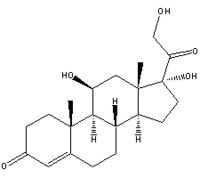Cortisol
|
|
| 11,17,21-trihydroxy-,(11beta)- pregn-4-ene-3,20-dione | |
| CAS number 50-23-7 | ATC code H02AB09 and others |
| Chemical formula | C21H30O5</sub> |
| Molecular weight | 362.465 |
| Bioavailability | ? |
| Metabolism | ? |
| Elimination half life | ? |
| Excretion | ? |
| Pregnancy category | C |
| Legal status | ? |
| Delivery | Oral tablets, intravenously, topical |
Cortisol or hydrocortisone, is a corticosteroid hormone synthesized in the zona fasciculata of the cortex of the adrenal glands. While the adrenal cortex also produces aldosterone (in the zona glomerulosa) and some sex hormones (in the zona reticulosa), cortisol is its main secretion.
| Contents |
Synthesis
Missing image
Reaction-Progesterone-Cortisol.png
Image:Reaction-Progesterone-Cortisol.png
Cortisol is synthesized from progesterone, the precursor of all steroid hormones. The conversion involves hydroxylation of C-11, C-17 and C-21.
Physiology
The amount of cortisol present in the serum undergoes diurnal variation, with the highest levels present in the early morning, and lower levels in the evening, several hours after the onset of sleep. Information about the light/dark cycle is transmitted from the retina to the paired suprachiasmatic nuclei in the hypothalamus. Changed patterns of the serum cortisol levels have been observed in connection with abnormal ACTH levels, clinical depression, psychological stress, and such physiological stressors as hypoglycemia, illness, fever, trauma, surgery, fear, pain, physical exertion or extremes of temperature. There is also significant individual variation, although a given person tends to have consistent rhythms.
Some effects of cortisol being secreted into the bloodstream are an increase in blood pressure and glucose concentrations. Also it increases the glycogen formation in the liver (Freeman, 2002). The release of cortisol inhibits functioning of the immune system, and bone formation.
Cortisol also inhibits the secretion of corticotropin releasing hormone (CRH), resulting in feedback inhibition of ACTH secretion. Some researchers believe that this normal feedback system may break down when animals are exposed to chronic stress.
Most serum cortisol, all but about 4 percent, is bound to proteins including corticosteroid binding globulin (CBG), and albumin. Only free cortisol is available to most receptors.
In normal release, cortisol has widespread actions which help restore homeostasis after stress. It acts as a physiological antagonist to insulin by promoting breakdown of carbohydrates, lipids, and proteins and so mobilizing energy reserves. In addition, immune and inflammatory cells have their responses to stress attenuated by cortisol.
These normal endogenous functions are the basis for the physiological consequences of chronic stress - prolonged cortisol secretion causes muscle wastage, hyperglycemia, and suppresses immune / inflammatory responses. The same sequelae arise from long-term use of glucocorticoid drugs.
Also, long-term exposure to cortisol results in damage to cells in the hippocampus. This damage results in impaired learning. However, short-term exposure of cortisol helps to create memories; this is the proposed mechanism for storage of flash bulb memories.
Pharmacology
As an oral or injectable drug, cortisol is also known as hydrocortisone. It is used as an immunosuppressive drug, given by injection in the treatment of severe allergic reactions such as anaphylaxis and angioedema, in place of prednisolone in patients who need steroid treatment but cannot take oral medication, and peri-operatively in patients on long-term steroid treatment to prevent an Addisonian crisis.
It is given by topical application for its anti-inflammatory effect in allergic rashes, eczema and certain other inflammatory conditions.
Compared to prednisolone, hydrocortisone is about 1/4th the strength. Dexamethasone is about 40 times stronger than hydrocortisone. For side effects, see corticosteroid and prednisolone.
See also
References
Online
- Hydrocortisone (http://www.duchs.com/information/Hydrocortisone) Fact Sheet
Printed
- Freeman, Scott (2002). Biological Science. Prentice Hall; 2nd Pkg edition (December 30, 2004). ISBN 0132187469.
- A. C. Guyton, J. E. Hall. Textbook of Medical Physiology. W.B. Saunders Company; 10th edition (August 15, 2000). ISBN 072168677X.de:Cortison

